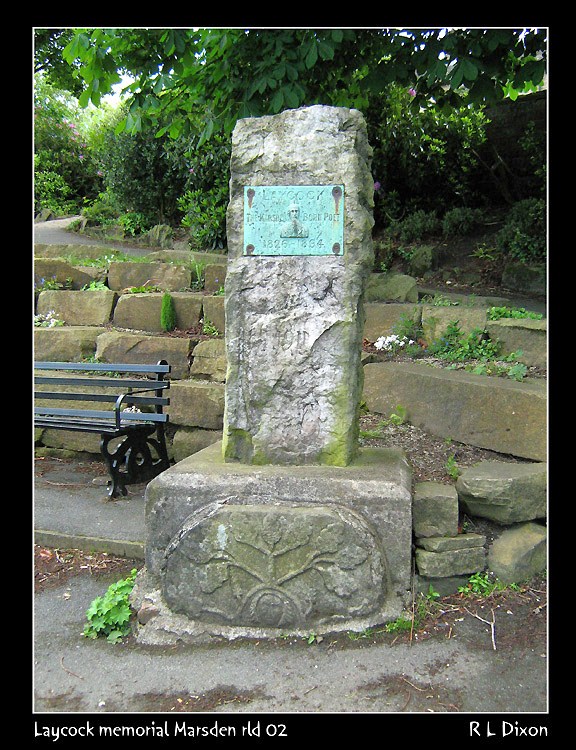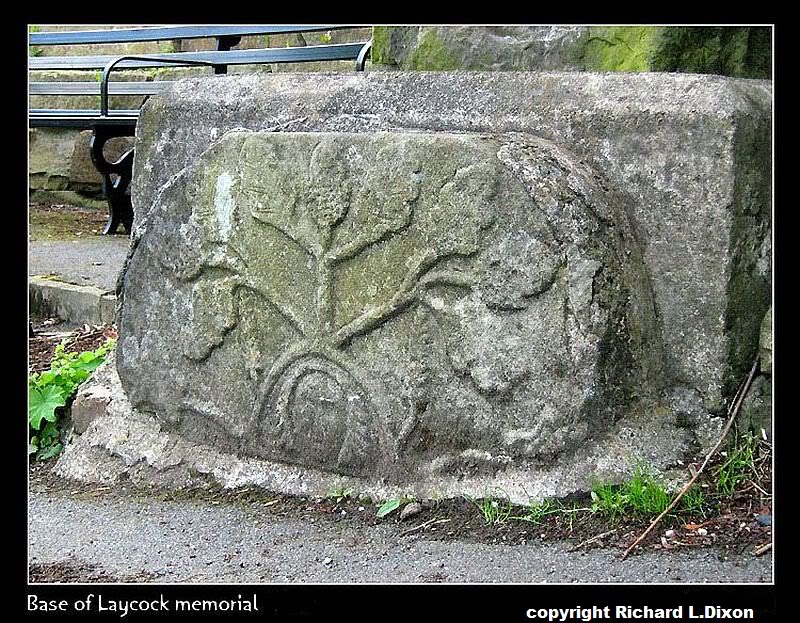Os grid reference SE.0512011485. The village of Marsden is located about 8 miles south-west of Huddersfield on the A62. The stone is located close to the bandstand in Marsden Park, Carrs Road, at the south-side of the village of Marsden.
This curious stone stands at the base of a monument that was set up in 1911 to commemorate the dialect poet Samuel Laycock (1826-1893). On the stone there are carvings in low relief of a garland or crown of oak leaves, acorns and other flowers. The stems of the foliage are interlinking around the edges and elsewhere on the stone. Near the bottom is the top part (head) of a figure that has sunrays radiating from the head, similar perhaps to the halo of a saint. In folklore oak leaves and acorns are often associated with Celtic saints in Wales and Ireland, so could the figure be a Celtic saint, or else a sun god ?
Local historians consider the carvings on the stone to be Celtic in origins, but I cannot be certain about that, nor do I know the age of the stone. Did this stone come from a church somewhere close by; it was apparently found somewhere in the vicinity but, where, we do not know. Anybody out there know anything about this strange, curious stone, please add a comment.

The following photo is by courtesy and permission of Mr Richard L.Dixon of Holmfirth, West Yorkshire.

Photo copyright © Richard L.Dixon 2011






This curious stone stands at the base of a monument that was set up in 1911 to commemorate the dialect poet Samuel Laycock (1826-1893). On the stone there are carvings in low relief of a garland or crown of oak leaves, acorns and other flowers. The stems of the foliage are interlinking around the edges and elsewhere on the stone. Near the bottom is the top part (head) of a figure that has sunrays radiating from the head, similar perhaps to the halo of a saint. In folklore oak leaves and acorns are often associated with Celtic saints in Wales and Ireland, so could the figure be a Celtic saint, or else a sun god ?
Local historians consider the carvings on the stone to be Celtic in origins, but I cannot be certain about that, nor do I know the age of the stone. Did this stone come from a church somewhere close by; it was apparently found somewhere in the vicinity but, where, we do not know. Anybody out there know anything about this strange, curious stone, please add a comment.

The following photo is by courtesy and permission of Mr Richard L.Dixon of Holmfirth, West Yorkshire.

Photo copyright © Richard L.Dixon 2011






Last edited by Sunbright57 on Fri Jun 03, 2011 6:27 am; edited 7 times in total



